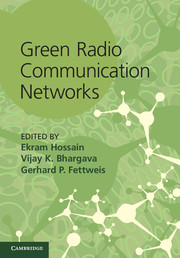Book contents
- Frontmatter
- Contents
- List of contributors
- Preface
- Part I Communication architectures and models for green radio networks
- Part II Physical communications techniques for green radio networks
- Part III Base station power-management techniques for green radio networks
- Part IV Wireless access techniques for green radio networks
- 12 Cross-layer design of adaptive packet scheduling for green radio networks
- 13 Energy-efficient relaying for cooperative cellular wireless networks
- 14 Energy performance in TDD-CDMA multi-hop cellular networks
- 15 Resource allocation for green communication in relay-based cellular networks
- Part V Green radio test-bed, experimental results, and standardization activities
- Index
- References
14 - Energy performance in TDD-CDMA multi-hop cellular networks
from Part IV - Wireless access techniques for green radio networks
Published online by Cambridge University Press: 05 August 2012
- Frontmatter
- Contents
- List of contributors
- Preface
- Part I Communication architectures and models for green radio networks
- Part II Physical communications techniques for green radio networks
- Part III Base station power-management techniques for green radio networks
- Part IV Wireless access techniques for green radio networks
- 12 Cross-layer design of adaptive packet scheduling for green radio networks
- 13 Energy-efficient relaying for cooperative cellular wireless networks
- 14 Energy performance in TDD-CDMA multi-hop cellular networks
- 15 Resource allocation for green communication in relay-based cellular networks
- Part V Green radio test-bed, experimental results, and standardization activities
- Index
- References
Summary
Introduction
In traditional cellular communication systems, there is only one path between a mobile station (MS) and a base station (BS). In a multi-hop cellular network (MCN) [1, 2] the direct communication path between the MS and BS is divided into several shorter transmission links. Since the signal attenuation exponentially increases with the distance, shorter links in terms of distance require much lower transmission power. Consequently, lower transmission power introduces lower interference, which is an important factor affecting the quality of calls. All these factors, low signal attenuation, low transmission power, and low interference will have a great impact on the system capacity and total transmission power. In [3], the authors propose a virtual cellular network (VCN) and investigate the effect of multi-hop relaying on transmission power. The losses considered in the system include the path loss, shadowing loss, and Rayleigh fading. The average transmission power decreases with the number of multiple hops. However, as stated in [4], the transmission power should include both transmission energy and the hardware consumption energy. Therefore, a more accurate model taking the transmitter and receiver processing energy into account should be considered. In a multi-hop system, the total energy consumed may exceed the direct transmission link [5] according to the model used in [4]. In [6], the energy consumed by every bit of an MCN system is analyzed in detail. From the results, we can see that the energy consumed per bit in the multi-hop system is much lower than the single-hop system.
Information
- Type
- Chapter
- Information
- Green Radio Communication Networks , pp. 309 - 330Publisher: Cambridge University PressPrint publication year: 2012
